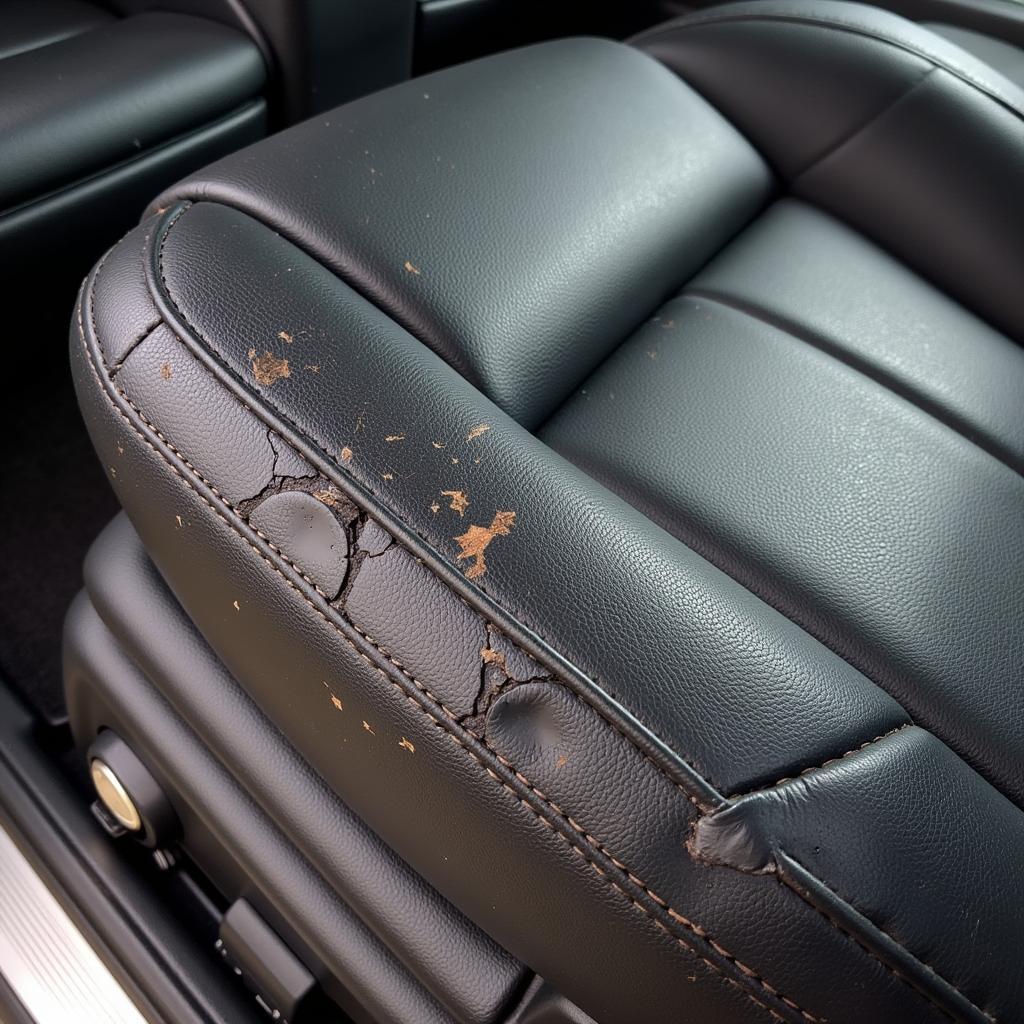Torn leather car seats can be an eyesore and even affect the resale value of your vehicle. But before you resign yourself to living with the damage or shelling out a fortune for replacements, you should know that repair is often a viable and cost-effective solution. Let’s delve into whether torn leather car seats can be repaired and explore the various options available.
Understanding the Damage: Types of Tears and Their Causes
Not all tears are created equal. Knowing the type and severity of the damage will help determine the best repair approach:
- Scratches: Superficial damage that hasn’t penetrated the leather’s top layer can often be addressed with leather conditioners or fillers.
- Small Tears and Punctures: These can be caused by sharp objects, pet claws, or even rough handling. Repairs typically involve patching and color matching.
- Large Tears and Rips: Extensive damage might require more complex techniques like leather grafting or even panel replacement.
Common causes of torn leather car seats include:
- Wear and Tear: Over time, friction from entering and exiting the vehicle can weaken and tear leather.
- Sharp Objects: Keys, knives, tools, and even children’s toys can easily puncture or tear leather.
- Sunlight Exposure: Prolonged exposure to UV rays can dry out leather, making it brittle and prone to cracking.
- Improper Cleaning: Using harsh chemicals or abrasive cleaners can damage the leather’s protective coating.
Repairing Torn Leather Car Seats: DIY vs. Professional Options
You have two primary options when it comes to repairing torn leather car seats:
1. DIY Repair Kits: A Budget-Friendly Solution for Minor Damage
DIY leather repair kits offer a cost-effective way to address minor tears, scratches, and burns. These kits typically include:
- Leather Filler: Used to fill in small gaps and tears.
- Color Matching Pigment: Allows you to blend the repair seamlessly with the surrounding leather.
- Adhesive: Bonds the filler and pigment to the leather surface.
- Application Tools: Spatulas, brushes, and sponges for precise application.
Pros of DIY Kits:
- Affordable
- Relatively easy to use for minor repairs
- Wide range of color options available
Cons of DIY Kits:
- Results can be inconsistent depending on skill level
- Not suitable for large or complex tears
- Repairs might not be as durable as professional methods
2. Professional Leather Repair: Expertise for Lasting Results
For significant damage or if you’re looking for flawless results, professional leather repair is the way to go. Experienced technicians have the skills and specialized tools to tackle even the most challenging repairs. They can perform:
- Leather Patching: Using a leather patch and adhesive to cover larger tears.
- Leather Grafting: Replacing a damaged section of leather with a donor piece from a hidden area of the car.
- Seat Panel Replacement: In cases of extensive damage, replacing the entire seat panel might be necessary.
- Color Matching and Dyeing: Ensuring a seamless blend with the existing leather.
Pros of Professional Repair:
- High-quality, durable repairs
- Expertise in handling complex damage
- Color matching for an invisible fix
Cons of Professional Repair:
- More expensive than DIY kits
- Might require leaving your car at the shop for a few days
“Choosing between DIY and professional repair depends on the extent of the damage and your budget,” advises John Miller, a seasoned automotive upholstery expert. “While DIY kits can be effective for minor imperfections, professional intervention ensures optimal results for significant tears and guarantees a seamless finish.”
Factors Affecting Leather Car Seat Repair Cost
The cost of repairing torn leather car seats can vary widely based on:
- Severity of Damage: Minor scratches are cheaper to fix than large rips requiring patching or grafting.
- Repair Method: DIY kits are the most affordable, while professional repairs involving complex techniques will cost more.
- Type of Leather: Repairing high-end leather like Nappa or Merino will be more expensive than standard leather.
- Location: Repair costs can vary depending on your geographic location and the expertise of available technicians.
ripped car seat leather repair
Preventing Future Tears: Proactive Care for Your Leather Seats
Prevention is key to extending the lifespan of your leather car seats and avoiding costly repairs in the future. Here are some tips:
- Regular Cleaning: Use a soft cloth and a pH-neutral leather cleaner to wipe down your seats weekly.
- Conditioning: Apply a leather conditioner every few months to keep the leather supple and prevent drying and cracking.
- UV Protection: Park your car in the shade or use a sunshade to protect your seats from damaging UV rays.
- Careful Entry and Exit: Avoid sliding across the seats with sharp objects in your pockets.
- Pet Protection: Use a seat cover or designated pet area to prevent scratches and punctures from pet claws.
how to repair old leather car seats
Conclusion
Torn leather car seats might seem like a major setback, but the good news is that they can often be repaired effectively. Whether you opt for a budget-friendly DIY solution for minor damage or seek professional expertise for more significant tears, addressing the issue promptly will help preserve the appearance and value of your vehicle’s interior. By understanding the repair options available and adopting preventive measures, you can keep your leather car seats looking their best for years to come.
FAQs
Can I use super glue to repair a tear in my leather car seat?
While super glue might seem like a quick fix, it’s not recommended for leather repair. Super glue can create a stiff, noticeable bond that’s prone to cracking over time. It can also damage the surrounding leather and make professional repair more difficult.
How long does it take to repair a torn leather car seat?
The repair time depends on the severity of the damage and the chosen repair method. DIY kits can typically be applied within a few hours, while professional repairs might take a day or two depending on the complexity.
Can I repair a tear in my leather car seat if it’s near the seam?
Tears near seams can be more challenging to repair and might require specialized techniques. It’s best to consult with a professional leather repair technician to assess the damage and determine the best course of action.
How can I prevent my leather car seats from cracking?
Regular cleaning and conditioning are crucial for preventing leather from drying out and cracking. Using a leather conditioner every few months will help keep the leather supple and moisturized.
Can I repair burns on my leather car seats?
Minor burns on leather car seats can sometimes be improved with DIY leather repair kits or professional treatments. However, severe burns that have penetrated deep into the leather might require panel replacement.
How do I choose the right color match for my leather car seat repair?
Most DIY leather repair kits and professional technicians offer a wide range of color options to match your car’s interior. It’s essential to choose the closest possible match to ensure a seamless repair.
Can I repair a torn leather car seat myself if I’m not very handy?
While some DIY leather repair kits are designed for beginners, it’s important to assess your skill level before attempting a repair. If you’re not confident in your abilities, it’s best to seek professional assistance to avoid further damage.
Looking for more information on car seat repairs? Check out these helpful resources:
Need assistance with your torn leather car seats? Contact us via WhatsApp: +1(641)206-8880 or Email: [email protected]. We have a 24/7 customer support team ready to assist you!


